Ask Ethan # 45: how far does the Multiverse extend?
- Transfer
The reader asks:
There are many questions asked at once, so let's start with the basics - from the Universe, which we know and love.
Each point in this video is a galaxy containing from millions to trillions of stars. The largest have a mass that is thousands of times greater than the mass of the Milky Way. And with all this, this “flight” shows us only 0.0002% of all galaxies, of those that are visible to us.
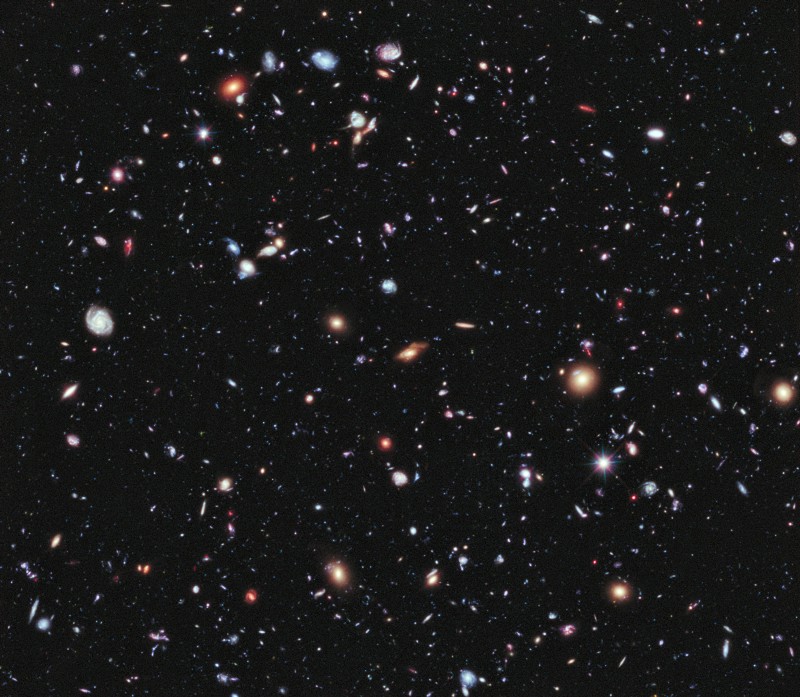
By choosing an unremarkable part of the sky, and sending the Hubble Space Telescope to it for 23 days, we were able to detect 5000 galaxies from a remote part of the Universe. To cover the entire sky of such sites would require 32 million - this means that there are at least a hundred billion galaxies in the Universe.
On the largest scale, our cosmic vision extends 46 billion light years in any direction. And then we only know that age in the Universe is finite, and that the speed of light is also finite.
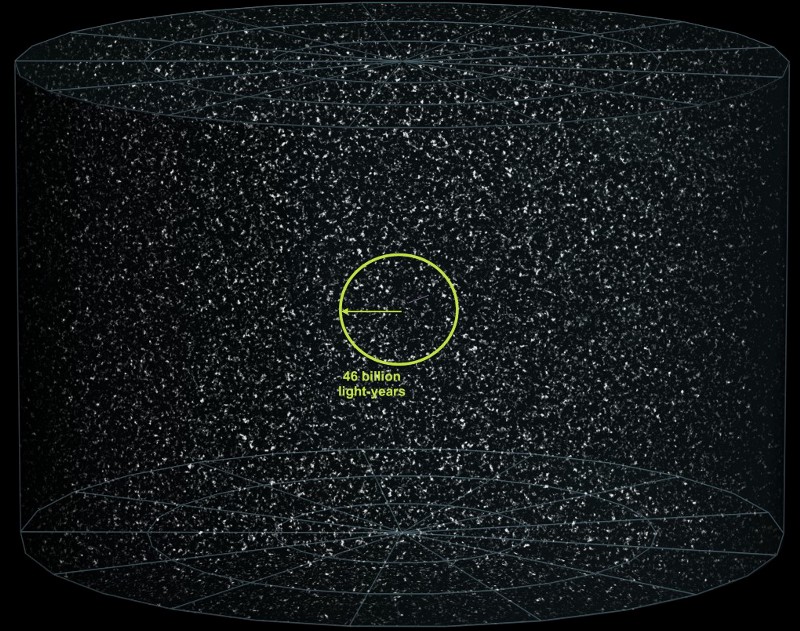
But as far as we know, the universe goes on and on. Our corner of the cosmos seems to be no different from others - in a rough approximation, the Universe is approximately uniform in structure and properties.
We can even study microwave cosmic radiation, the residual radiation from the time when the Universe was so hot that it could not form neutral atoms - they were immediately broken into pieces.
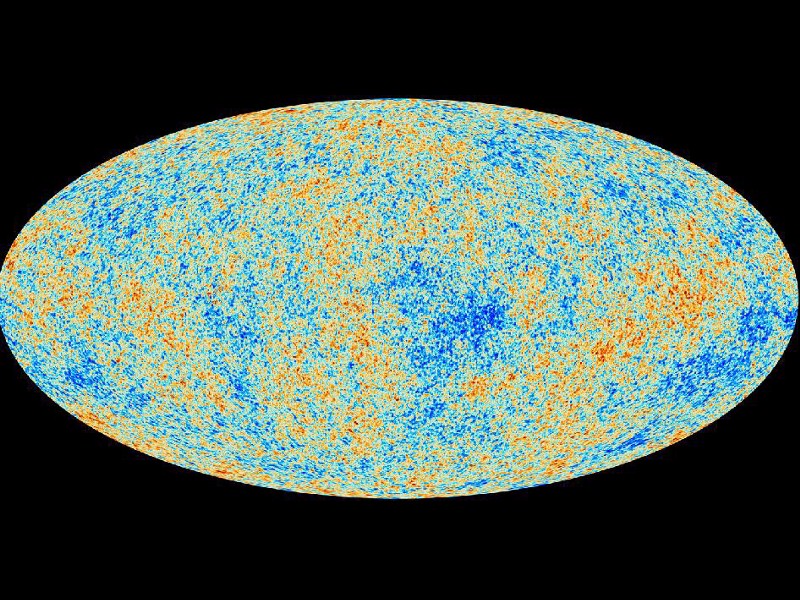
This is a snapshot of the radiation of the universe from a distance of 46 billion light years in all directions. It was emitted only after 380,000 years after the Big Bang. Everything indicates not only that the Universe is about the same in density and properties everywhere, but also that the laws of physics are the same everywhere, and also that the Universe does not close in on itself like a closed surface.
This tells us that the Universe, what we see, is only a part of the whole Universe. All the stars, galaxies and radiation, which reached the Milky Way during the existence of the Universe, are just a part of what was created during the Big Bang.
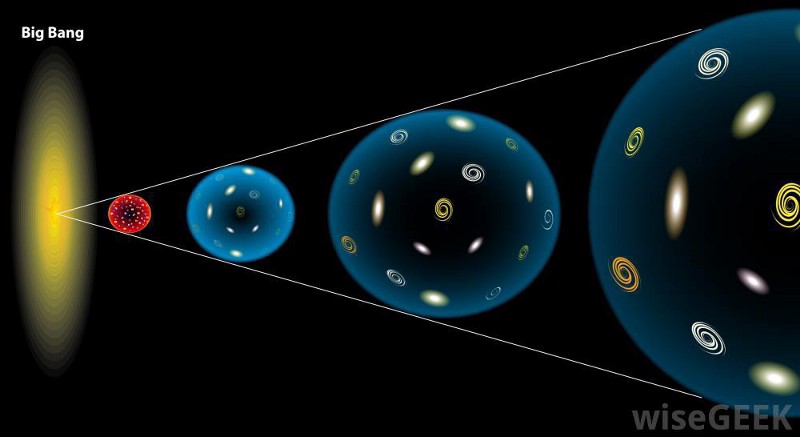
And, despite the fact that the scale of the Universe is unknown to us, all observations suggest that in every part of it:
- the same laws of physics work, at any time, in any place
- every area has its own history, and it is not united causal relationships with others (not sharing information with them)
- they all originated from one big bang
In other words, even outside the monitored Universe, there is simply an additional space of the same Universe - what we call the zero level of the multiverse, which is essentially not the multiverse.
But we believe that the multiverse exists - and not just our Universe. Everything comes from our understanding of how the universe was born.

At present, the Universe is expanding (and has expanded since the Big Bang), in proportion to the amount of matter and energy in it. When she was younger, hotter, denser and more energetic, the expansion rate was greater. Today, the energy density is less and continues to decrease, asymptotically striving for a small nonzero value.
This non-zero value is known as dark energy inherent in the space itself. Its value is small, but matter and radiation continue to dissipate in the expanding universe, while dark energy remains constant. As a result, dark energy already contributes to the expansion of the Universe more than the other components.
The most amazing thing is that the Universe was doing the same thing before the Big Bang, only with much greater energy and speed. This period was called cosmic inflation.

Inflation causes space-time to expand exponentially, and if it happened in the past with a lot of energy, then this exponential expansion was unrealistically fast. For only 10 -32seconds a region the size of a subatomic particle would expand to sizes larger than today's observable part of the Universe.
Due to the properties of quantum field theory, it doesn’t matter how inflation started - most areas of space would expand further exponentially and to infinity. But this clearly did not happen in our part of the Universe - at some point, inflation ended, and gave birth to our present Universe. And the mechanism that ended inflation for us, had to finish it in the rest of the universe.
Although the regions of the Universe, where inflation continues, grow faster than those where it ended, there must be a large number of unrelated areas of space-time, where inflation has ended - in the picture below they are marked X:
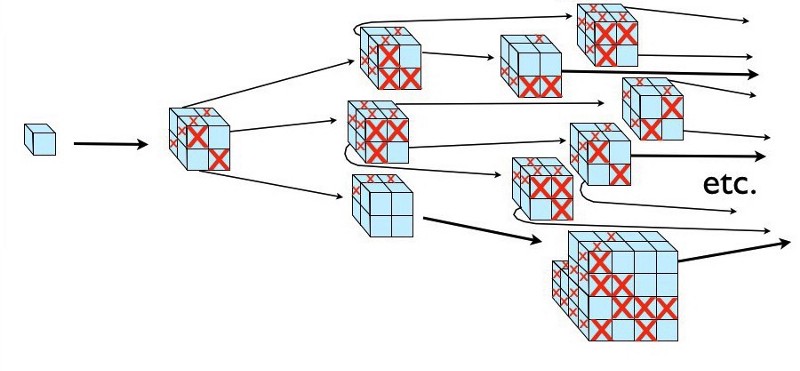
These separate regions of the Universe, not connected with each other, experience the Big Bang with the end of inflation - independently of each other. This is what we call the first level multiverse. Usually we throw four different levels of the multiverse, and this one, in the context of cosmic inflation, is most likely to occur.
This is the answer to the reader’s final question - there are different Universes separated from each other, each of which had an independent Big Bang that occurred as a result of the explosion that gave rise to the Universe known to us.
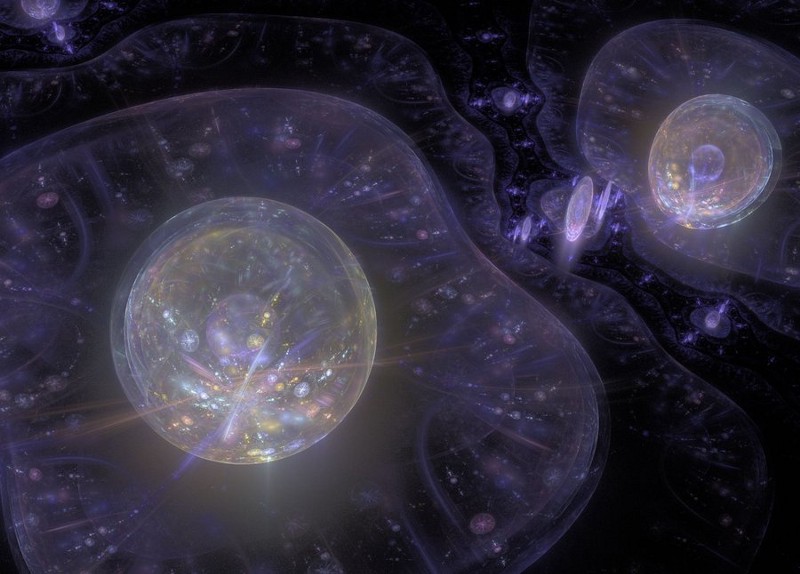
What about other universes? Are they required to have an identical set of laws of physics?
The second-level multiverse hypothesis says that the physical constants of other universes will be different from ours. It is based on a set of assumptions, usually not voiced:
Let's see what we know about inflation, and what happens at its end.
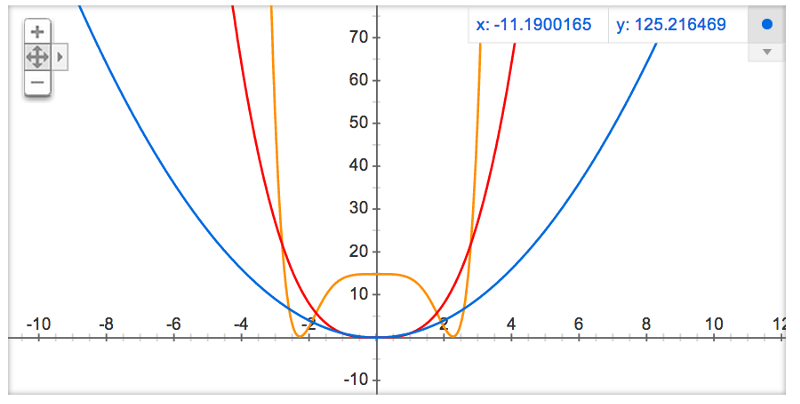
It is believed that cosmic inflation is a quantum field, which has some nonequilibrium value during inflation, but at its end tends to equilibrium. From measurements of microwave cosmic radiation, it is known that at the end of inflation the value of its energy was much lower than the value on the Planck scale. This is usually considered the energy at which the defining symmetry constants are violated. Only in the case of the orange curve in the picture, and only in the case when its minima have different values, and only in cases when the inflation field interacts with different fundamental constants, the other Universe will have different constants.
This gives reason to believe that other variants of symmetry breaking (electroweak, or Higgs symmetry, for example) do not lead to a change in the fundamental interaction constants. In other regions of our Universe this happened, and did not lead to a change in the constants.
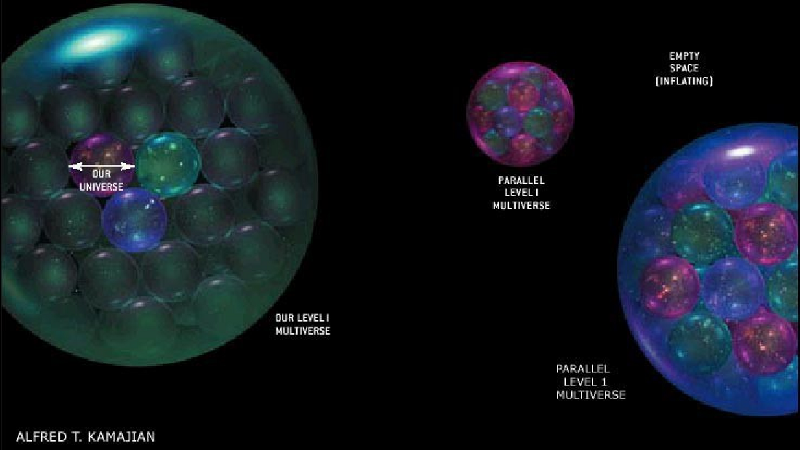
Therefore, although the idea of having other first-level multiverse universes with other constants looks attractive, we have every reason to believe that this is hardly possible, and there is no reason to believe that the likelihood of their occurrence is great.
What about the multiverse higher levels?
They can be found only deliberately misinterpreting the many-worlds interpretation of quantum mechanics.

Some people mistakenly declare that every time you make a quantum “decision” you find yourself in one of two possible universes that have coincided with each other before that.
However romantic and attractive it may be, this is not what physics says! A lot of elements make a non-zero contribution to the wave function of the Universe, and there are not so many Universes, and when you make measurements, you place yourself in one Universe, and not in another. In other words, the physics of multi-world interpretation says that the quantum wave function of the Universe can be represented as a superposition of states — and not at all that all possibilities are realized somewhere in the Universe. A multi-world interpretation is completely admissible, but this does not mean that there exist identical parallel universes.

And the 4th level multiverse is so far away in the realm of assumptions and hypotheses that it makes no sense to spread about it for a long time. She argues that there are all possible universes corresponding to all possible mathematical constructions that can control the universe.
So, answering the reader's question:
- our Universe extends further than its observable part, and all of it was created during the Big Bang, and all has the same laws of physics and constants
- because of inflation, there are other Universes, with other Big Explosions, but most likely, their laws and constants coincide with ours
- all of them are not united by cause-effect relationships with us and cannot influence us, just as we do
- each has its own unique story, and many may have intelligent observers in themselves, seeking answers to such questions.
Could you explain more about the multiverse theory? Will there be different laws in different universes? Or will they all have some fundamental laws? Or will it all be at the same time? Do they come from the center of our universe, or does each of them have its own big bang point?
There are many questions asked at once, so let's start with the basics - from the Universe, which we know and love.
Each point in this video is a galaxy containing from millions to trillions of stars. The largest have a mass that is thousands of times greater than the mass of the Milky Way. And with all this, this “flight” shows us only 0.0002% of all galaxies, of those that are visible to us.

By choosing an unremarkable part of the sky, and sending the Hubble Space Telescope to it for 23 days, we were able to detect 5000 galaxies from a remote part of the Universe. To cover the entire sky of such sites would require 32 million - this means that there are at least a hundred billion galaxies in the Universe.
On the largest scale, our cosmic vision extends 46 billion light years in any direction. And then we only know that age in the Universe is finite, and that the speed of light is also finite.

But as far as we know, the universe goes on and on. Our corner of the cosmos seems to be no different from others - in a rough approximation, the Universe is approximately uniform in structure and properties.
We can even study microwave cosmic radiation, the residual radiation from the time when the Universe was so hot that it could not form neutral atoms - they were immediately broken into pieces.

This is a snapshot of the radiation of the universe from a distance of 46 billion light years in all directions. It was emitted only after 380,000 years after the Big Bang. Everything indicates not only that the Universe is about the same in density and properties everywhere, but also that the laws of physics are the same everywhere, and also that the Universe does not close in on itself like a closed surface.
This tells us that the Universe, what we see, is only a part of the whole Universe. All the stars, galaxies and radiation, which reached the Milky Way during the existence of the Universe, are just a part of what was created during the Big Bang.

And, despite the fact that the scale of the Universe is unknown to us, all observations suggest that in every part of it:
- the same laws of physics work, at any time, in any place
- every area has its own history, and it is not united causal relationships with others (not sharing information with them)
- they all originated from one big bang
In other words, even outside the monitored Universe, there is simply an additional space of the same Universe - what we call the zero level of the multiverse, which is essentially not the multiverse.
But we believe that the multiverse exists - and not just our Universe. Everything comes from our understanding of how the universe was born.

At present, the Universe is expanding (and has expanded since the Big Bang), in proportion to the amount of matter and energy in it. When she was younger, hotter, denser and more energetic, the expansion rate was greater. Today, the energy density is less and continues to decrease, asymptotically striving for a small nonzero value.
This non-zero value is known as dark energy inherent in the space itself. Its value is small, but matter and radiation continue to dissipate in the expanding universe, while dark energy remains constant. As a result, dark energy already contributes to the expansion of the Universe more than the other components.
The most amazing thing is that the Universe was doing the same thing before the Big Bang, only with much greater energy and speed. This period was called cosmic inflation.

Inflation causes space-time to expand exponentially, and if it happened in the past with a lot of energy, then this exponential expansion was unrealistically fast. For only 10 -32seconds a region the size of a subatomic particle would expand to sizes larger than today's observable part of the Universe.
Due to the properties of quantum field theory, it doesn’t matter how inflation started - most areas of space would expand further exponentially and to infinity. But this clearly did not happen in our part of the Universe - at some point, inflation ended, and gave birth to our present Universe. And the mechanism that ended inflation for us, had to finish it in the rest of the universe.
Although the regions of the Universe, where inflation continues, grow faster than those where it ended, there must be a large number of unrelated areas of space-time, where inflation has ended - in the picture below they are marked X:

These separate regions of the Universe, not connected with each other, experience the Big Bang with the end of inflation - independently of each other. This is what we call the first level multiverse. Usually we throw four different levels of the multiverse, and this one, in the context of cosmic inflation, is most likely to occur.
This is the answer to the reader’s final question - there are different Universes separated from each other, each of which had an independent Big Bang that occurred as a result of the explosion that gave rise to the Universe known to us.

What about other universes? Are they required to have an identical set of laws of physics?
The second-level multiverse hypothesis says that the physical constants of other universes will be different from ours. It is based on a set of assumptions, usually not voiced:
- there is a type of symmetry that recovers during inflation
- at the end of inflation, symmetry is broken
- in different universes symmetry is broken in different ways
- it is the broken symmetry that determines the fundamental constants of the Universe.
Let's see what we know about inflation, and what happens at its end.

It is believed that cosmic inflation is a quantum field, which has some nonequilibrium value during inflation, but at its end tends to equilibrium. From measurements of microwave cosmic radiation, it is known that at the end of inflation the value of its energy was much lower than the value on the Planck scale. This is usually considered the energy at which the defining symmetry constants are violated. Only in the case of the orange curve in the picture, and only in the case when its minima have different values, and only in cases when the inflation field interacts with different fundamental constants, the other Universe will have different constants.
This gives reason to believe that other variants of symmetry breaking (electroweak, or Higgs symmetry, for example) do not lead to a change in the fundamental interaction constants. In other regions of our Universe this happened, and did not lead to a change in the constants.

Therefore, although the idea of having other first-level multiverse universes with other constants looks attractive, we have every reason to believe that this is hardly possible, and there is no reason to believe that the likelihood of their occurrence is great.
What about the multiverse higher levels?
They can be found only deliberately misinterpreting the many-worlds interpretation of quantum mechanics.

Some people mistakenly declare that every time you make a quantum “decision” you find yourself in one of two possible universes that have coincided with each other before that.
However romantic and attractive it may be, this is not what physics says! A lot of elements make a non-zero contribution to the wave function of the Universe, and there are not so many Universes, and when you make measurements, you place yourself in one Universe, and not in another. In other words, the physics of multi-world interpretation says that the quantum wave function of the Universe can be represented as a superposition of states — and not at all that all possibilities are realized somewhere in the Universe. A multi-world interpretation is completely admissible, but this does not mean that there exist identical parallel universes.

And the 4th level multiverse is so far away in the realm of assumptions and hypotheses that it makes no sense to spread about it for a long time. She argues that there are all possible universes corresponding to all possible mathematical constructions that can control the universe.
So, answering the reader's question:
- our Universe extends further than its observable part, and all of it was created during the Big Bang, and all has the same laws of physics and constants
- because of inflation, there are other Universes, with other Big Explosions, but most likely, their laws and constants coincide with ours
- all of them are not united by cause-effect relationships with us and cannot influence us, just as we do
- each has its own unique story, and many may have intelligent observers in themselves, seeking answers to such questions.
